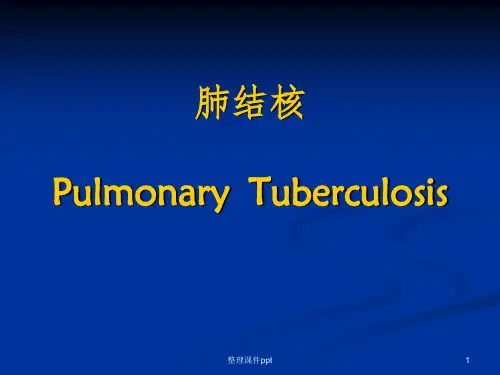粟粒性肺结核精品PPT课件
- 格式:pptx
- 大小:6.54 MB
- 文档页数:48











粟粒結核と鑑別疾患The characteristic radiographic findings∙innumerable, 1-3mm, noncalcifiednodules scatteredthroughout bothlungs, with mildbasilarpredominance∙ consolidation,cavitation,calcified lymphnodes, andlymphadenopathy(30%)∙Normal radiographic findings in the early stages of disease are well recognized and occur in 25%-40% of persons at initial presentation ∙typical miliary lesions may not be visible until 3-6 weeks after hematogenous dissemination∙ Rarely, a diffuse alveolar pattern is observed in patients with associated adult respiratory distress syndrome∙CT can demonstrate miliary disease before it becomes radiographically apparent∙At thin-section CT, a mixture of both sharply and poorly defined, 1-4mm nodules are seen in a diffuse, random distribution often associated withintra- and interlobular septal thickening (Radiology. 1999;210:307-322.) High resolution CT findings of miliary tuberculosis∙ HRCT scans showed miliary nodules in 24 patients, which varied in size from 1 to 5 mm, with either sharply (n = 21) or poorly (n = 3) definedmargins. The nodules had diffuse random distribution throughout both lungs and within the secondary pulmonary lobules∙In 23 patients, areas of ground-glass opacities (GGOs) were observed with variable extent and distribution. The patients who had dyspnea showedlarge areas of GGOs, and two patients with impending adult respiratorydistress syndrome revealed extensive GGOs. Both intralobular reticulation and interlobular septal thickening were seen in 10 patients (J ComputAssist Tomogr. 1998 Mar-Apr;22(2):220-4.)Snowstorm appearance∙in theabsenceofadequatetherapy,they mayincreaseto 3 to 5mm indiameter,a findingseen inapproximately 10% of cases∙By this time, they may have become almost confluent, presenting a “ snowstorm” appearance (Fraser and Pare’s : Diagnosis of Diseases of the CHEST p828.)Acute Interstitial PneumoniaHRCT scan at the level of rightintrapulmonary vein showsground-glass attenuation andconsolidation associated withtraction bronchiolectasis andbronchiectasis (arrows) andarchitectural distortion, which isshown as displacement ofbronchi (white arrows). AmericanJournal of Respiratory andCritical Care Medicine Vol 165.pp. 1551-1556, (2002)Acute interstitial pneumonia: high-resolution CT findings correlated with pathologyOBJECTIVE: The purpose of this study was to evaluate the relation between pathologic phases and high-resolution CT (HRCT) findings in patients with acute interstitial pneumonia (AIP). MATERIALS AND METHODS: Our retrospective review found 14 patients with AIP who were included in this study. Three patients were pathologically diagnosed as having AIP by open lung biopsy, and the other 11 patients were confirmed at autopsy. In eight of the 11 autopsy patients, the postmortem lungs were inflated and fixed by Heitzman's method, and a postmortem HRCT scan was obtained on all 11 autopsy patients. Paying special attention to the disease stage, we selected 27 areas of the lung from antemortem or postmortem HRCT and correlated them with pathologic findings. RESULTS: Nine areas of the lung that showed increased attenuation without traction bronchiectasis were associated with either the exudative (n = 5) or early proliferative (n = 4) phase of AIP. Eleven areas of increased attenuation with traction bronchiectasis were associated with either the proliferative (n = 4) or fibrotic (n = 7) phase of AIP. Honey-combing, observed in one area of the lung, corresponded to restructuring of distal airspaces and dense interstitial fibrosis. Six spared areas, within or adjacent to areas of increased attenuation, showed pathologic findings of the exudative phase. CONCLUSION: HRCT findings were not specific for the pathologic findings in our patients with AIP. Nevertheless, the findings of traction bronchiectasis in areas of increased attenuation suggested the proliferative or fibrotic phase.(Am. J. Roentgenol., Feb 1997; 168: 333 - 338)“crazy-paving” patternIntralobular reticular opacities were moreprevalent in patients with AIP than in those withBOOP. Such opacities are one of thecomp onents of the “crazypaving”pattern.(Radiation Medicine: Vol. 18 No. 5, 299–304 p.p., 2000 )Patchy or diffuse areas of ground-glassattenuation and air-space consolidation; usuallyrandom distribution; may show intralobularreticular opacities.(Radiology. 1999;211:555-560)90歳女性(粟粒結核)Hypersensitivity pneumonitisHypersensitivity pneumonitis. (A) Full-inspiration HRCT of hypersensitivity pneumonitis shows diffuse, small, poorly circumscribed centrilobular nodular opacities. There are subtle changes of mosaic lung attenuation. (B) Expiratory HRCT in same patient shows air trapping in multiple lobules throughout both lungs with background of diffuse poorly circumscribed centrilobular nodular opacities. Note lobules of lower attenuation where there is air trapping (arrows) secondary to thebronchiolitis component of hypersensitivity.(American Journal of Respiratory and Critical Care Medicine Vol 168. pp. 1277-1292, (2003))73歳男性(粟粒結核)まとめ1.粟粒結核の鑑別診断として急性間質性肺炎、過敏性肺臓炎、原発性肺癌を経験した。